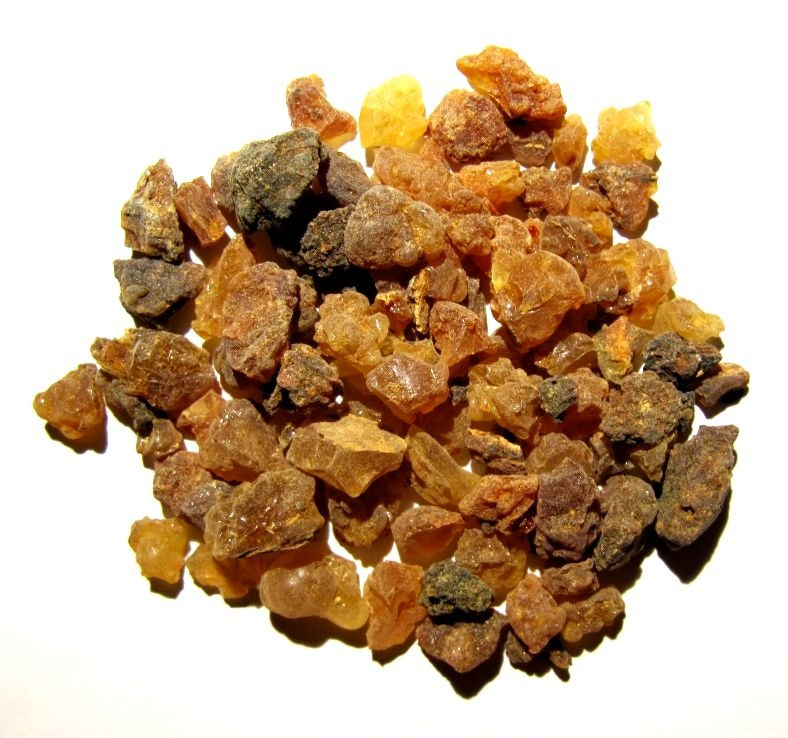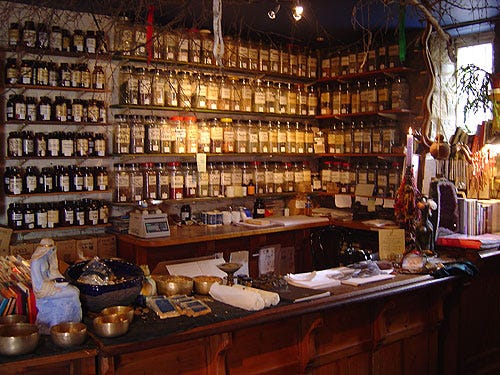Myrrh - 'A Magi's Cure'
A Magical & Medicinal Substance - Profile; Properties; Uses; History; & More
Myrrh. Why - ‘A Magi’s Cure’?
The first meeting with Myrrh for most people in western cultures would have been as one of the gifts that the three wise men (the Magi) brought to the infant Jesus; but Myrrh has a history dating back thousands of years that boasts antiseptic and anti-inflammatory properties.
The ancient Egyptians used Myrrh by the boatload; as salves for wounds and sores, facial treatments, perfume, insect repellent, incense and it was even a key ingredient in their embalming process. It is both a magical and medicinal substance, one that wise men (Magi) and women throughout the ages have known about and used.
Binomial Name:
Commiphora myrrha
Plant Family:
Burseraceae
Common names:
Common Myrrh, Myrrha, Gum Myrrh, Myrrhe
Description:
Myrrh gum comes from a small, spiny, deciduous shrubby tree native to Yemen, Somalia, Eritrea and eastern Ethiopia which reaches a height of 4 metres. The base of the trees trunk is thick and looks swollen, stems like this are known as ‘pachycaul’. The bark is papery and can be reddish in colour to bluish grey; many gnarly thorny branches grow off the trunk.
The trifoliate (having 3 leaflets), elliptical to lanceolate leaves (a narrow oval shape tapering to a point at each end) are pinnately compound (featherlike), alternate and 5-35mm in length. They are mid green in colour with serrated edges.
The 4-petaled flowers are 3-4mm in length and white to creamy white in colour.
The resin exudes from the tree readily without the tree having to be cut or scored.
History:
The ancient Egyptians used this resin as an antiseptic. As incense - it was a key ingredient in the famous Egyptian incense Kyphi which was used as a medicine and a fumigant. It was used in the embalming process and they even used it to repel fleas.
The medical practitioners of the ancient Greeks and Romans (Hippocrates, Pliny the Elder etc.) had already recognised and documented Myrrhs antiseptic, anti-inflammatory and analgesic properties, and the demand for this expensive dried sap was so great that it had made the southern Arabians the richest people on earth.
By the time that Jesus was born Myrrh was worth more than its weight in Gold (as was Frankincense - comprising the three gifts from the Magi). The Magi knew the value of Myrrh for its medicinal properties - it was indeed their ‘cure’.
The rise of Christianity and subsequent fall of the Roman empire (despite the significance given to Myrrh and Frankincense in the New Testament) caused Myrrh to go out of favour in Europe. Christianity expressly forbade the use of incense due to its associations with Pagan worship and the trade routes were obliterated.
The rise of modern medicine dealt further blows to the use of natural herbs and resins. However the knowledge and practices were not totally obliterated; with some communities and practitioners still continuing to prize these natural substances for their recognised healing properties.
The wise women and cunning men of the rural areas in Europe; along with ancient cultures such as the Chinese, kept the secrets. In the 11th century the Anglo-Saxons used myrrh as a medicine, the German herbalist Hildegard von Bingen in the 12th century used it more as a spiritual means of banishing negativity writing that ‘it chases from the person phantasms, magic spells, and demonic invocations made with evil words and evil herbs’.

Pharmacological Activity of Myrrh
Myrrh is listed as having the following properties:
Antiseptic:- preventing the growth of disease-causing microorganisms
Analgesic:- acting to relieve pain
Antibacterial:- prevents the growth of bacteria.
Anticancer: - Modern pharmacological and clinical studies have shown that elemene in myrrh has a good anticancer effect. (In vivo studies are now beginning to provide proof - 3.2.2. https://www.ncbi.nlm.nih.gov/pmc/articles/PMC6749531/)
Anti-inflammatory:- reduces inflammation
Anti-fungal:- active against fungi, prevents fungal growth
Antimicrobial:- destroys or stops the growth of microorganisms
Expectorant:- promotes the secretion of sputum by the air passages
Cicatrisant:- skin-healing, wound healing or cell regenerative
Insect repellent:- a substance that deters insects from approaching or settling
Myrhh contains a large number of compounds which have yet to be identified.
Essential Oil of Myrrh
“The main chemical constituents of Myrrh (and Frankincense) are terpenoids and essential oils. Their common pharmacological effects are anti-inflammatory and anticancer.” (National Library of Medicine - National Centre for Biotechnology Information)
It is known that many of the effective compounds of a resin reside in the resin portion rather than the oil.
The National Library of Medicine also provides the following information: “Modern studies have shown that myrrh is 3–8% essential oil, 25–40% alcohol-soluble resin, and 30–60% water-soluble gum.
The chemical constituents of essential oils include monoterpenes (64–69), sesquiterpenes (70–80), and small molecular aromatic compounds.
Chemical constituents in resins include diterpenoids (81–85), triterpenoids, steroids, and lignans.
The main components of gum are sugar, protein, and ash.”
Essential oils are extracted by using a distillation process. The compounds within the resin (especially the triterpenoids; many of which have significant antitumor activity) are too large and are too heavy to distill with the oil. Some essential oil manufacturers try to claim that their product contains triterpenoids (especially AKBA - Acetyl-11-keto-β-boswellic acid); this is impossible, if they did they would be a solid, not an oil.
We are missing a great deal of the picture by failing to use the complete substance. A lot more work needs to be done.
Uses
Many resins have common beneficial effects on the respiratory system, having a cleansing action that is useful against cold, catarrh, sore throats and other common nose and throat maladies.
For more in-depth information about Myrrh’s anticancer effects please use the link provided above in the Pharmacological Activity of Myrrh section.
Myrrh is also considered effective in combating many common problems within the mouth; (ulcers, weak teeth and gums) and is incorporated into toothpastes for this purpose.
Its cicatrisant properties make it useful in applying to the skin to aid eczema, ulcers, boils, bedsores and minor wounds. It lends itself to being made into salves, balms and creams for this purpose.
With antifungal properties it is also helpful in dealing with fungal skin problems.
Used as a fumigant - to repel fleas and mosquitoes.
The combination of its properties also gives it a tonic action on the digestive system to ease diarrhoea and flatulence and causes it to act as a uterine stimulant which results in relief from painful periods.
Cautions
As a uterine stimulant its use should be avoided in pregnancy.
Information provided in this article is purely informative. It is not to diagnose or suggest treatment for ailments.
Always consult with a medical practitioner before trying any herbal remedies; especially for the first time, or if you take any prescribed medications.
Just because a substance is natural does not mean that you cannot be allergic to it.
Studies
Today you can find hundreds of medical studies and papers on the internet relating to the benefits of Myrrh; much of the scientific research is within the last few years (at the date of writing). Areas that have been researched include Antibacterial, Antiviral and Antifungal and Anticancer, amongst many others. Out of substances that class as a natural antibiotic the effectiveness of Myrrh seems to leave all others in the dust.
It was so powerful that in some tests, it even destroyed multidrug-resistant strains - those bacteria which our medications are no longer effective against (or have little effect against).
Many of the tests being undertaken are in vitro (in a petri dish in the lab) and are for the purposes of learning, not as part of a drug approval process. The process to find out if something is safe, if it works, and what the best dosage amounts are if it does takes many years. In vivo (tested on whole, living organisms or cells) studies are now starting to be published.
Pharmaceutical or biotech companies are likely to isolate and patent a proprietary compound derived from the plant to be motivated to spend the vast amount of money needed to develop a drug from it. If they are not able to patent something, they cannot make money from it. If there is no chance of making money they will not conduct tests.
Isolating the effective compound (when they are able to identify it) does not mean that it is going to be effective in isolation. Plant chemicals (phytochemicals) or compounds (two or more phytochemicals) work in synergy together; using the whole means that you get the full spectrum. It is not always possible to tell how a single phytochemical or compound will work on its own (if at all).
The studies that need to be undertaken need to answer the question ‘Will a small part ever work as well as the whole?’
In-depth scientific information can be found here: Commiphora myrrh: a phytochemical and pharmacological update.
We do not email ALL articles (we don’t want to inundate your inbox). Please see the publication for other new articles.
Our friends over at The Herbal Apothecary have myrrh, botanical herbs and other resins for sale.






